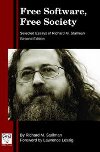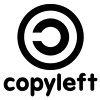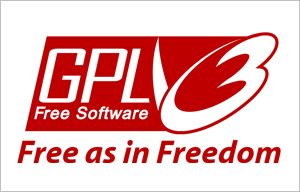Copyright? Legalese? Software licenses? Can you think up something more likely to evoke a huge yawn?
Actually, legalese aside, the impact of copyright law on the field of educational technology is both enormous and fascinating. By now, you’ve probably heard of Creative Commons, or even taken advantage of resources that were made available under Creative Commons terms of use. Those cool icons that tell us we can use someone else’s stuff? – those represent licenses. The licenses authorize you to use someone else’s work with minimal strings attached. Just like Creative Commons has popularized free culture, sharing, and cooperation in web-based and other media; the licenses attached to Free and Open-Source software tell us how we can use, remix, and redistribute free software. They’re also philosophical statements on cooperation and societal values!
The lesson addresses these topics:
- Copyright and Licensing
- GNU and Stallman’s Ideals
- “Copyleft” and the GPL
- Other F/OSS Licenses and their Implications
Advanced Organizer
During the lesson, look for answers to the following questions:
- What is copyright?
- Computer programs are not one of the 8 categories of copyrightable works, so how is it that they receive copyright protection?
- In what circumstances can the author of an original work, NOT claim copyright protections?
- Why does Stallman believe that proprietary software is antisocial, that it builds walls to divide people?
- Stallman states that we’re conditioned with what assumptions about proprietary software?
- Why was the FSF formed?
- What is copyleft, and what does it achieve?
- What is the LGPL? How and why does it differ from the GPL?
- What is GNU/Linux?
- What does “compatibility” mean in the context of software licenses?
- How does the GPL make it impossible to use GPL-licensed code in proprietary software?
- What is dual licensing, and how is it possible on GPL’ed software?
- Why are software patents an enormous threat to F/OSS developers?
Synchronous Meeting
Collaborate Web Conference (Optional)
![]()
- Monday, 9/9/13
- 6:00PM HST
Please join the web conference 15 minutes early (5:45PM) to re-test your microphone and headset. During class; we will be discussing some of the material from the past two weeks. Be prepared to ask questions and to participate in answering those posed. Those who are unable to attend synchronously will need to review the recording, and post a summary plus personal reactions in our course discussion board (Laulima).
- Participation is worth 10 points, however an alternative assignment is available below for anyone who can not attend the session. You will get full participation points only if you are socially present and participate – that means listening, “raising your hand”, responding in a manner that evidences that you’re familiar with the past two weeks of material.
Walk-through
1. Read the following sections of Copyright Basics, from the United States Copyright Office:
- What is Copyright? (pp. 1-2)
- Who Can Claim Copyright (p. 2)
- What Works Are Protected (p. 3)
- International Copyright Protection (p. 6)
Copyright is a legal protection given to the authors of original works, usually for a limited time. Copyright is specific to legal jurisdictions, so US copyright law differs from others. Reviewing the required sections of Copyright Basics, from the United States Copyright Office will help you to understand the basics of who enjoys protection, and what qualifies.
Copyright prevents others from making specific uses of a protected (copyrighted) work. A license specifies the terms under which non-copyright holders (that’s you!) can use such protected works. Thus, copyright law is the basis for nearly all software licensing. (Patents, another form of legal monopoly, can also be licensed – but we’ll save the software patent topic for later.)
2. Read sections of Stallman’s Free Software, Free Society on GNU:
- Chapter 2 The GNU Project (pp. 7-23)
- Chapter 4 The GNU Manifesto – Some Easily Rebutted Objections to GNU’s Goals (pp. 31-36)
In our last lesson, you learned about Richard Stallman’s definition of Free Software and the user freedoms it protects. We’ll now learn the history and details of his GNU (a recursive acronym for “GNU’s not UNIX”) project, around which the Free Software movement began. Stallman holds that the proprietary software system, in disallowing sharing and modifications, is antisocial and unethical.
3. Read Stallman’s Free Software, Free Society on Copyleft:
- Chapter 22 Copyleft: Pragmatic Idealism (pp. 129-131)
Copyleft, as you read, uses copyright law to achieve the opposite of it’s usual purpose. Rather than creating an artificial monopoly, copyleft enforces universal availability. In Stallman’s words “Proprietary software developers use copyright to take away the users’ freedom; we use copyright to guarantee their freedom.” The GNU General Public License (GPL) is the specific copyleft implementation used for most GNU software. It prevents anyone from turning GPL-licensed code into proprietary software, ensuring the four freedoms of Free Software
4. Read the following on FSF Licenses
- Chapter 27 of Stallman’s Free Software, Free Society: Introduction to the licenses (pp. 165-170)
- Why the Affero GPL


In chapter 27, we’re introduced to most of the FSF’s specific licenses and their rationales: GPL, LGPL, FDL, and the evolution of the latest versions of GPL and LGPL (version 3). The GPL is the most widely-used free software license in the world by most accounts. One other license, the Affero GPL, is described by this online article: Why the Affero GPL. This license is a simple modification that enforces GPL terms on software that is made for access over a network, ie web applications. Wikipedia’s list of AGPL web applications give us an idea of the extensive reach of this license. You might recognize a few high profile applications from the Educational Technology field such as the edX MOOC platform, the Instructure Canvas learning management system, and ownCloud file storage.
5. Read Chapter 10, Licenses, Copyrights and Patents, in Producing Open Source Software:
Read only the following headings (PDF pp. 157-169)
- Terminology
- Aspects of Licenses
- The GPL and License Compatibility
- Choosing a License
- Copyright Assignment and Ownership
- Dual Licensing Schemes
- Patents
In his chapter on Licenses, Copyrights, and Patents, Karl Fogel provides a concise summary of the important terminology and aspects of common F/OSS licenses. He also describes a common method of making money with F/OSS – the dual licensing arrangement. The Canvas LMS is a great example of dual licensing. Instructure makes the software available under the AGPL, but has the option to release the code under other (including proprietary) licenses as well. How can this be? See this feature comparison matrix which shows how Instructure is able to offer additional features with its hosted (“cloud” version) Canvas LMS, despite the AGPL license on the community (open-source) version. Pay attention in Fogel’s sections on Copyright Assignment and Dual Licensing – you can even look at Instructure’s Contributor License Agreement (CLA) to see an example of how an open-source project aggregates and tracks copyright on its code.
Activity
You should now have a handle on what Free Software licenses and open-source software licenses encompass. You also know what copyleft is, and the specific terms of the GPL.
- Take the Software Diagram Challenge. In this venn diagram, you need to correctly label the 5 ovals representing Free Software, open-source software, GPL software, copyleft software, and “for free” software. Use our course readings to select a citation for each label – the citation should support your rationale for placing that label. Good luck!
- You are free to debate the labels in our class discussion forum – see the topic “Software Diagram Challenge”. Give hints, and share citations, but don’t provide the answers directly.
- This is not a graded assignment. After discussion in Laulima, I will post my solution for you to review.
Assignments
For anyone who did not attend the BBC Web Conference discussion this week:
- Review the Web Conference recording. Post a summary of the discussion and your reactions and/or questions to Laulima Forums.
- Those who did attend the Web Conference should feel free to respond with comments
Test: Module 1
You will find the test in Laulima, under the Tests tool. Tests are timed, and allow only one submission. Cooperating on test responses is prohibited, and evidence of cheating will be addressed through the UHM Student Code of Conduct. Study well, and good luck!
Additional Material
- Comparative Table of Free and Open-Source Licenses (wikipedia)
- Quick comparator for Licenses
- A Legal Issues Primer for Open Source and Free Software Projects (HTML)
- Free Software, Free Society (PDF)
- The Initial Announcement of the GNU Operating System (pp. 25-26)
- Why Software Should be Free (pp. 43-56)
- In this essay, Stallman articulates his stance that software should not have owners – that in effect, copyright law creates negative consequences for society when applied to software. He carefully dismantles the assumptions and arguments commonly accepted about software, providing fascinating analogies that argue for alternate methods of financing software development.


